Human Flower Project
Weaving among Hardiness Zones
Kentuckian Allen Bush pushes the limit with new plants from Florida, seduced by the USDA’s new maps.
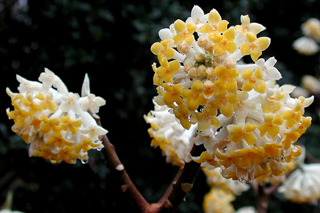
Edgeworth chrysantha: an early bloomer, “insanely intoxicating”
Photo: W.J. Hayden
By Allen Bush
The long awaited interactive garden tool was released a few weeks before our Florida vacation. I didn’t study the new map, though I could see Louisville, Kentucky, was colored some shade of green. There were adjacent greens but I’m red-green colorblind. It was all a muddle.
On our vacation to Sanibel Island, a few weeks later, Mary Vaananen, my Jelitto colleague, emailed and announced that Louisville had been upgraded from 6b (-5 F to 0 F/-20.6 C to -17.8 C) to 7a (0 F to 5 F/-17.8C to -15 C). I started shopping for native Florida plants the next day. Florida and Kentucky have a lot in common. Florida once sat at the bottom of an ocean floor; so did Kentucky. In 1824, botanist Constantine Rafinesque wrote in Annals of Kentucky: “The briny oceans cover the whole land of Kentucky.” Kentucky was only 10 degrees north of the equator, when we were sitting under a shallow ocean in the Devonian Period 380 million years ago.
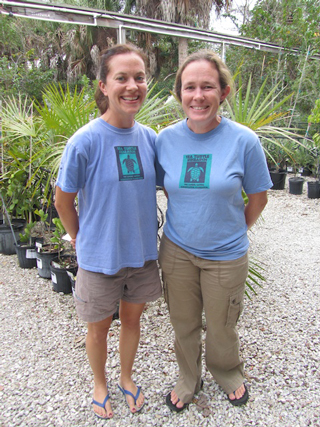 Audrey Fusco and Jenny Evans of Sanibel-Captiva Conservation Foundation Nursery draw some Zone 6ers to tropical plants.
Audrey Fusco and Jenny Evans of Sanibel-Captiva Conservation Foundation Nursery draw some Zone 6ers to tropical plants.
Photo: Allen Bush
Who knows where global warming and magnetic shifts of the pole will take us in the next few million years? But I’m getting ready. There was an impressive range of Florida native trees, shrubs and herbaceous plants at the neat-as-a-pin Sanibel-Captiva Foundation Conservancy Nursery. Most of the plants, of course, were unfamiliar to me. It didn’t make them any less appealing. I picked-up a needle leaf palm (Rhapidophyllum hystrix), a woody cycad commonly called coontie (Zamia pumila), a beach sunflower (Helianthus debilis) and a Florida tickseed (Coreopsis leavenworthii).
I was in two worlds, dreaming about Florida and my oasis back home. The possibility of the new Zone 7a had never crossed my mind. Zones 8 or 9 now seemed worth a go. Zone envy no more.
Besides all sorts of new plant possibilities, there’s a short-term advantage to my new Kentucky paradise. The humongous dog eating, alligator wrestling Burmese python is heading north. It will take it awhile to slither up I-75 to Kentucky. The invasive snake has done a number on the Everglades already. Try to find a raccoon or a rabbit. Heaven forbid it lands on precious Sanibel, but there seems to be little standing in its way. But keep your eyes peeled. Armadillos are another matter. My friends Robyn Brown and Troy Marden, who live in Nashville, only 175 miles south of Louisville, complained that these “possums on the half shell” have started to make a mess of their gardens. Not to worry. The armadillos will be no match for the Burmese python.
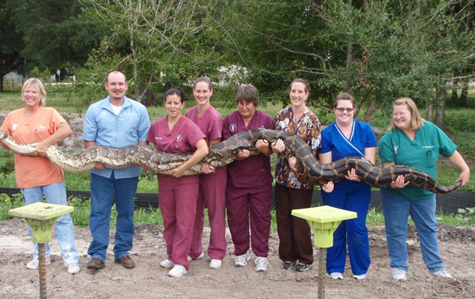
A Burmese python held by eight staffers at Okeechobee Veterinary Hospital
Photo: Okeechobee Veterinary Hospital
We’ve been enjoying Zone 8b this winter with fewer than 16 nights approaching the mid-teens. The January electric bill was sitting in a pile in the front hall to prove it. The average temperature was 41 F, 10 degrees warmer than the same period a year ago in our neighborhood serene. (A January tornado, however, touched down and blew off some roofs in eastern Jefferson County. The storm watch basement bivouac doesn’t usually begin until March.) While Sanibel enjoyed a toasty 85 F (29.4 C) on February 1st, it was a spring-like 65 F (18.3 C) at home. Otis Knox called from Salvisa, Kentucky, and told me there were crocus and winter aconites in flower in his yard. I count on them sometime later in February or early March, but I can’t recall either of these little bulbs flowering so early in February.
Punxsutawney Phil popped-out of his Pennsylvania hole the next day and got spooked when he saw his shadow. The groundhog’s shadow meant there would be six more weeks of winter. Winter? It could arrive and it wouldn’t surprise me. I’d rather deal with it sooner rather than later. Five years ago after a warm March and early April, we had temperatures in the mid-teens for a couple of nights beginning on the 19th of April. Dogwood blooms looked like they’d been scorched by flamethrowers.
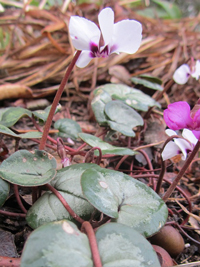 Cyclamen coum ‘Silver Leaf’ welcomes Florida travelers back to Louisville
Cyclamen coum ‘Silver Leaf’ welcomes Florida travelers back to Louisville
Photo: Allen Bush
Rose and I pulled into the driveway on Sunday, February 5th. Primroses, witch hazels, Cyclamen coum and lots of hellebores were in full bloom. The early flowering Prunus mume ’Peggy Clarke’ was in fine form, too. I don’t expect the rollout of the Japanese flowering apricot until much later in the month. It was planted seven years ago with a hope and prayer. My prayers were answered. It’s still alive. It was one of J.C. Raulston’s favorite flowering trees. I planted it in his memory, even though I knew I was running a risk. The fragrant rose-pink blooms were worth it. There was no good reason to plant the oriental paper plant Edgeworthia chrysantha, except that the late winter blooms have a delicate, rich perfume that is insanely intoxicating. I’ve babied this Daphne relative for a few years. But it is on easy street now…I hope.
Zone maps serve the green industry the way the slogan Drink Responsibly does for beer, wine and spirits. A little fun can’t hurt, just don’t go overboard. I hold my wine consumption to two glasses – sometimes two big glasses. – on average. Plants are a different matter. A bit more fun and hell’s bells, I’ll buy the next round. And you can bet your bottom dollar we’ll be staggering across a wobbly line into Zones 8 or 9, pushing a nursery cart full of once forbidden fruit.
Be careful, though. There are annoying statistical anomalies that pop-up and, when they do, all bets are off on cold hardiness. The kind souls of commercial greenhouses and nurseries will be generous to a fault with replacement plants, but there is seldom much justification. They don’t want you to be disappointed; they hope you’ll love your garden as much as they do theirs, but you probably won’t. And because you won’t, you’ll need to atone personally for acts of god. The grief may seem overwhelming. The New Guinea native, Went’s Hardy Elephant Ear (Alocasia wentii) marked Zone 7b, will be way out of its element when a cold-ass storm blows down from Alberta, Canada. The Louisville temperature plummeted to – 20 F (-28.8 C) as recently as 1994, not in the last ice age.
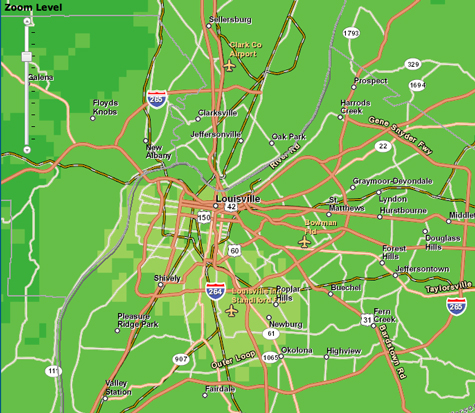
Patchwork of new hardiness zones in and around Louisville, KY
Imge: USDA
After a week of tropical excitement, I finally surveyed the USDA’s Plant Hardiness Zone Map. I needed help with the green color zone gradients. I checked with Mary Vaananen again. She took a closer look and emailed back that both our neighborhoods – make no mistake – were still frozen in Zone 6b. (-5 F to 0 F/ -20.6 C to -17.8 C). I could take heart. Zone 7a (0 F to 5 F/ -17.8 C to -15 C) was only a couple of blocks away in the urban heat island of downtown Louisville. As the planet continues to warm and the magnetic pole shifts a wee bit more toward the equator, Top Hill Road can set its sights on warmer winters and hotter summers, too—like it or not.

